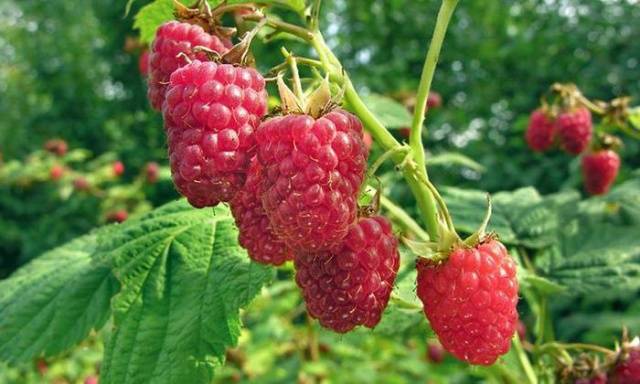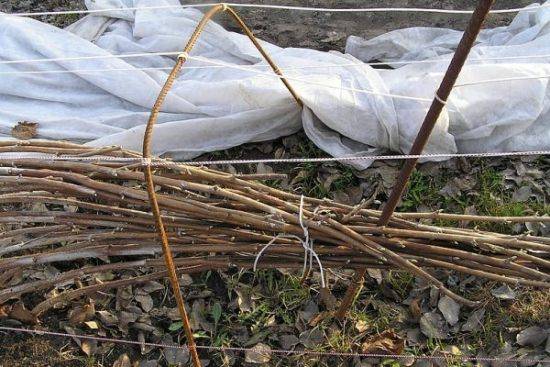Content
How nice it is to enjoy ripe raspberries on a summer day! Warmed by the summer sun, the berry exudes a wonderful aroma and just begs to be eaten. It is in July, at the very top of summer, that the Novost Mikolajczyk variety raspberries ripen. The berries have an amazing wild raspberry aroma and a very beautiful dark color, as in the photo.
Why are raspberries so beneficial?
With a low calorie content - only 46 calories per 100 g of product, this berry contains many useful substances:
- organic acids;
- sugars represented by glucose and fructose;
- tannins;
- a lot of dietary fiber;
- essential oils that make this berry so fragrant.
The berry is also rich in vitamins: a lot of folic acid, there are other B vitamins, it contains vitamin A, nicotinic acid, beta-sistosterol, and also a lot of vitamin C. Among the minerals, iron is the leader, there is also potassium, copper, calcium, magnesium and zinc .
The healing properties of raspberries stem from its composition. Among the organic acids in raspberries is acetylsalicylic acid. It is known as aspirin. This substance in the berry is of natural origin and therefore does not give side effects if the leaves or fruits are used to treat colds, flu and other respiratory diseases.Raspberries are also indicated for joint pain and radiculitis.
Raspberries are used as a hemostatic, antitoxic, antisclerotic agent. Folic acid, which is contained in the berry, is very well absorbed, so it is extremely useful for women during pregnancy. Raspberry berries, as well as its leaves, have a diuretic effect. An infusion can be prepared from the leaves, which is effective for diarrhea. For those who suffer from depression and nervous tension, raspberries will provide invaluable help, as they contain a lot of copper. And this substance is included in many antidepressants.
Among the numerous varieties of raspberries, there are those that are well-known, but there are also those known to few gardeners. Raspberries of the Novost Mikolajczyk variety belong to them. It is not often found in gardens, although it has many valuable qualities.
Description and characteristics
Raspberries of the Novost Mikolaichik variety were bred at the Siberian Horticulture Research Institute. It is not included in the State Register of Breeding Achievements, but reviews from gardeners indicate that the Novost Mikolaychik variety is quite worthy and deserves breeding.
Varietal features:
- variety Novosti Mikolaychik is non-remontant and bears fruit once;
- The ripening period of the variety is early, but, according to gardeners, it is more likely to ripen in the mid-early period;
- raspberry shoots of this variety have an average height, growing from one and a half to two meters;
- the shoot-bearing ability of the raspberry variety Novosti Mikolajczyk is average, it decreases with age;
- young shoots of this raspberry variety are light green, while last year’s shoots are brown;
- raspberry shoots of the Novost Mikolajczyk variety have a waxy coating and a small number of thorns, mostly located on their lower third;
- on the underside of the leaves, which are slightly curled, there is also a small number of small thorns - this is a distinctive varietal feature;
- this raspberry variety is sensitive to drought and, if there is a lack of moisture, it delays the ripening of berries by up to 20 days;
- raspberries of this variety have an oblong conical shape with a blunt end, they are painted in a beautiful dark crimson color;
- ripe raspberries are not prone to shedding;
- the size of the berries can be considered large, their weight is more than 4 g;
- the taste of the berries is very good with a balanced content of acids and sugars;
- raspberries of the Novost Mikolaychik variety have a good yield - up to 2 kg of berries per bush;
- The use of berries is universal.
To complete the description and characteristics, it should be noted that the Novost Mikolajczyk raspberry variety is distinguished by excellent health and excellent frost resistance.
To ensure that raspberry bushes of the Novost Mikolajczyk variety do not suffer from diseases and produce an excellent harvest, they need to be cared for correctly.
Agricultural technology
Raspberries are the most demanding of all berry crops. There are no trifles in its cultivation. Raspberries respond to any error in care by reducing the yield and reducing the size of the berries.
Site selection and soil preparation
Raspberry News Mikolajczyk is a light-loving plant. When grown in shade, the yield is reduced. Therefore, for raspberries you need to choose only well-lit areas. It is very important that they are protected from strong prevailing winds.
Raspberries are very demanding on soil. On lean soil, the bushes will suffer from lack of nutrition and a good harvest will no longer be obtained. Criteria for choosing soil:
- light, loose, breathable;
- with a high humus content;
- with neutral soil reaction;
- with a good supply of moisture, but without stagnation of water;
- The groundwater level should be no higher than 1 meter.
Areas in lowlands are not suitable for raspberries, since not only does water often stagnate there, but return frosts are always stronger.
Before planting raspberries, the area needs to be prepared. It is best to start preparing the season before planting. For each square meter of plot contribute:
- up to 20 kg of organic fertilizers;
- up to 200 g of deciduous tree ash;
- up to 120 g of superphosphate;
- about 30 g of potassium salt.
The soil is carefully dug up, choosing the roots of perennial weeds.
How to plant
Raspberries can be planted in different ways. Their choice depends on the number of plants to be placed. If you are starting a large plantation, it is more rational to plant bushes in trenches. The depth of the trench is 40 cm, the width is 60 cm. The distance between adjacent trenches must be at least two and a half meters.If you are going to plant only a few bushes, you can simply dig holes about 40 centimeters deep and wide. On wet soils, drainage must be provided to avoid stagnation of water. The distance between neighboring raspberry bushes when planting should be about a meter. Thickened plantings not only contribute to the occurrence raspberry diseases, but also significantly reduce the yield.
Landing rules:
- For planting, choose plants with one trunk, a well-developed root system and several basal buds. Do not plant several plants in one hole hoping for a large harvest. The result will be the opposite: the raspberry bushes, growing, will compete with each other for moisture and nutrition, which ultimately will not allow them to fully develop.
- The best time to plant raspberries is autumn, about 3 weeks before firm frost sets in. By planting raspberries in the fall, we give them the opportunity to take root well. Therefore, with the beginning of the growing season in the spring, the roots will already feed the plants well.
- A raspberry seedling is placed on a small earthen mound, poured into a hole or trench, the roots of which must be well straightened;
- they are covered with fertile soil mixed with humus, ash and a small amount of mineral fertilizers;
- At least 5 liters of water must be poured onto each plant;
- the shoot is cut so that a stump about 30 cm high remains;
- The soil around the plants should be mulched with organic material in a layer of 8 to 10 cm thick.
Further care
Planting is only the beginning of the life of a raspberry bush. Both the harvest and the lifespan of the raspberry plantation will depend on proper care. Agree, setting up a new raspberry garden every 10 years is a troublesome task.With proper care, the lifespan of raspberries in one place can be extended to 30 years or more. Raspberries of the Novost Mikolajczyk variety, like any other plant, need watering, fertilizing, and shaping. She also needs shelter for the winter, especially where the winters are frosty or snowless.
Watering
Raspberries are a very moisture-loving plant. Due to the shallow root system, it reacts very sensitively to lack of moisture. Therefore, watering should be regular. The top layer of soil should not be allowed to dry out.
Feeding
Without proper nutrition, you cannot get a harvest. Raspberries of the Novost Mikolajczyk variety need feeding throughout the growing season. In spring, these are nitrogen fertilizers, for example, urea. During the formation of buds, it requires complex fertilizer. Raspberries respond well to foliar feeding with urea. To do this, it is enough to dilute just 10 g of fertilizer in one bucket of water and spray the bushes over the leaves on a cloudy but not rainy day.
Raspberries are one of the few plants that respond well to the application of fresh manure. Experienced gardeners combine mulching of raspberry plantations with fertilizing, laying the entire surface of the beds with a layer of manure about 10 cm thick.
This mulching provides the raspberries with constant nutrition.
Formation
Typically, raspberry fruiting is concentrated at the ends of 2-year-old shoots. To increase the yield you need to use double shaping. What does it consist of?
- In the first year of shoot growth, you need to pinch it, removing from 5 to 15 cm from the top, as soon as it grows to a height of 120 cm. This usually happens in late May - early June. Even if the raspberry shoot has not grown to the required height, you should not be late with pinching. Otherwise, the second-order shoots, which will begin to grow from the axillary buds, will not have time to ripen before winter.
- In early spring, each regrown raspberry branch is pinched again. This promotes the growth of third-order shoots. With this formation, the berries will produce all shoots. They will be heavily loaded with the harvest, so a high-quality garter to the trellis is required.
For raspberries of the Novost Mikolajczyk variety, all fruit-bearing shoots must be cut off immediately after harvesting. How many replacement shoots should be left? If double shaping is used, their number should not exceed 7 pieces, since the dimensions of each shoot are rather large.
Where winters are frosty or with little snow, raspberries must be bent down, securing the shoots with special metal pins. They will need to be covered with additional snow. The thickness of the snow cover should not be less than 50 cm.
More information about double shaping of raspberries and other subtleties of growing can be seen in the video:
Raspberry Novost Mikolajczyk is a worthy variety for any garden.






















